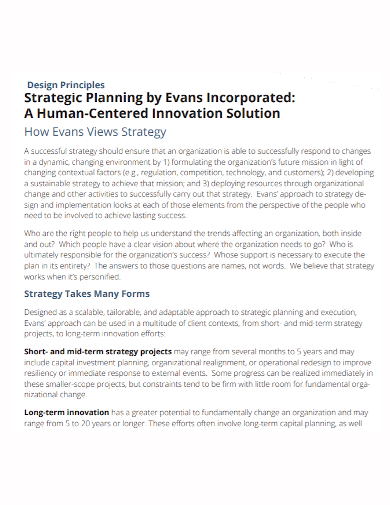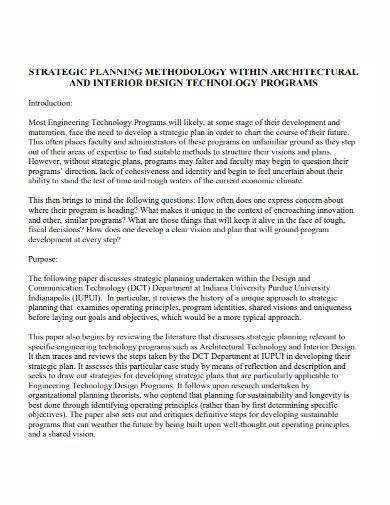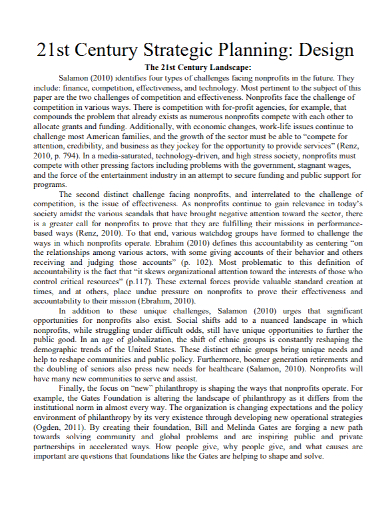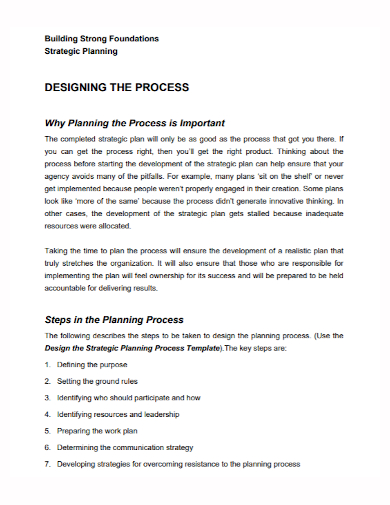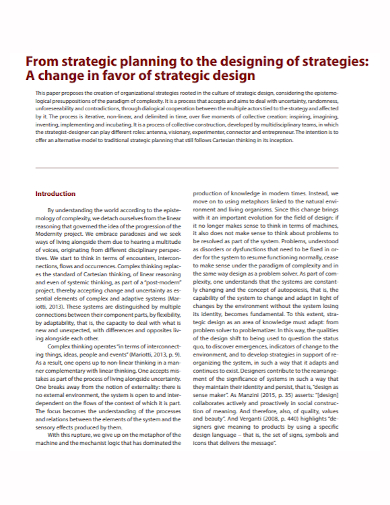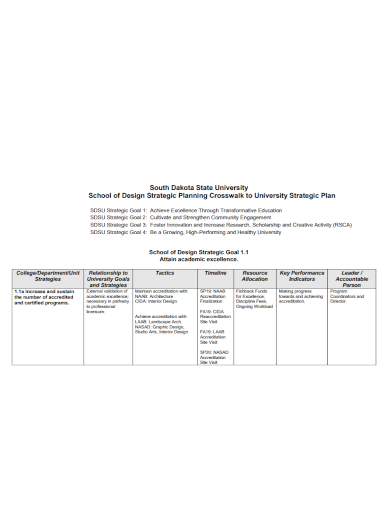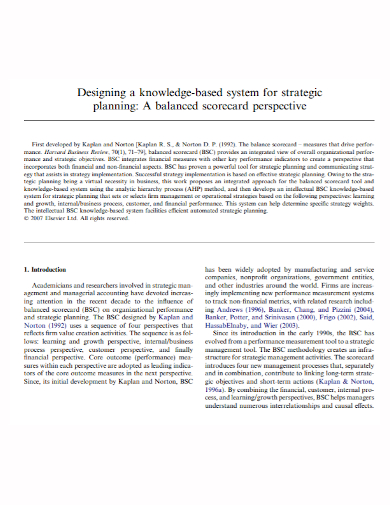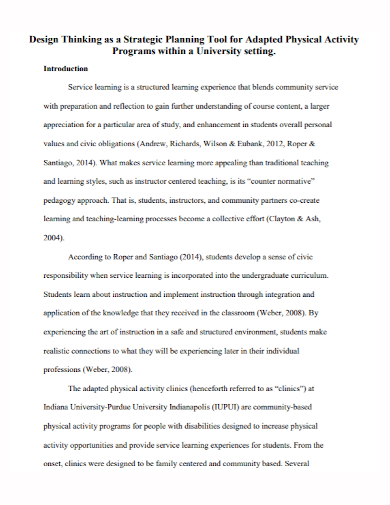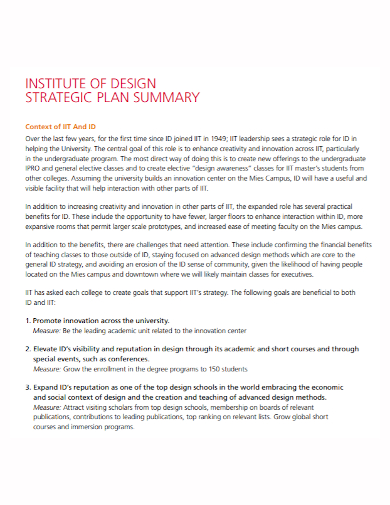Strategic thinking is frequently confused with strategic planning, and vice versa. They’re not the same. Strategic planning is gathering data and deciding on a course for the company or project to follow in order to attain its objectives. Strategic thinking entails everyone in the organization/design team finding and participating in activities that contribute to the organization’s success on a regular basis. Thinking strategically is seeing and comprehending the wider picture of where a team or organization needs to go before taking action. Everyone takes part. We focus more on problem-solving, develop clearer strategies, promote proactive behavior, and build a better link with employees who feel more involved and empowered when we think strategically.
10+ Design Strategic Plan Samples
It is feasible to grasp the context, analyze it, produce ideas, test them, and observe their impact before adopting them by using Immersion, Analysis, Ideation, Prototyping, and Implementation. We can investigate the web that makes up the success of planning by linking the company’s primary goals with its employees’ wishes and existing information. This helps you to motivate and stimulate commitment from all parties involved in the strategy’s execution, as well as establish cross-sector relationships. As a result, a structured result with a higher possibility of being effective is attainable.
1. Design Strategic Plan Template
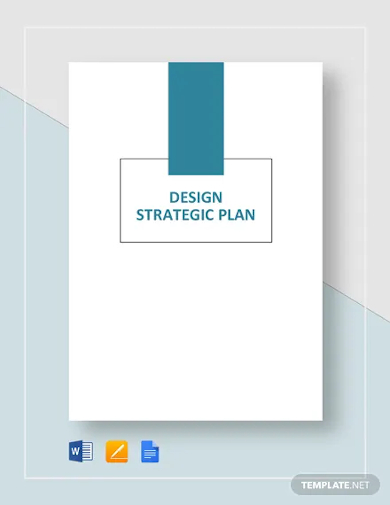
2. Design Innovation Strategic Plan
3. Design Technology Strategic Plan
4. Design Strategic Plan
5. Design Implementation Strategic Plan
6. Building Design Strategic Plan
7. Sample Design Strategic Plan
8. School Design Strategic Plan
9. Design System Strategic Plan
10. University Design Strategic Plan
11. Design Strategic Plan Summary
Strategic Planning Implemented in Design
A strategy’s design and execution are both an art and a science. A strategic mindset, like design, improves with time with practice. When it comes to putting strategic planning into practice in design, you can use the following framework:
- Assessment – The first step is to learn everything about your project. The understanding must be comprehensive, and it may involve an examination of the opportunities and restrictions, as well as a view of the larger picture of the design project through the eyes of your company.
- Understanding – Making meaning of your project in terms of business and design objectives is the next step. The project’s outcome must be linked to the company’s objectives.
- Learning – At this stage, you should ask a lot of questions to learn about the milestones and tasks that must be completed in order for the business’s primary objectives to be directly supported. Who are you designing the project for? This is one of the most critical questions to ask.
- Executing – You’ve completed all of your project’s analysis and understanding of the design and commercial aspects. It’s time to put the approach into action. To do so, you’ll need to enlist the help of your entire team, as techniques based on design operate best in partnership.
- Checking and monitoring – Several tasks will be completed during the design process. As a result, you should continue to monitor and reevaluate the effectiveness of completed tasks to ensure that you reach the specified objectives and goals. At first, strategic planning through design may appear to be a difficult task. However, forming a strong link between the managers and the design team will help your project succeed.
FAQs
What are the advantages of strategic planning in design?
You can better connect your project with the needs of your customers by using strategic planning in design. This will also prevent your design team from having to make several adjustments or wasting time on a design that isn’t going to function. When business goals and design goals are linked, it allows upper management and the design team to have better and stronger interactions. When strategic planning is enabled through design, collaboration is enhanced since the entire team is focused on accomplishing a single goal. The benefits of the managers’ and design team’s collaboration persist for a long time, and they flow into future projects as well.
What is design strategy?
The term “design strategy” refers to the intersection between corporate strategy with design thinking.
Why is it important to develop a tactical thinking approach?
Working with internal stakeholders requires designers to adopt a tactical thinking approach. The designer acquires a greater grasp of corporate objectives and user goals as a result of this process and is able to translate these needs into meaningful design solutions.
A strategic thinking attitude is required to execute a successful design strategy—a mindset that allows us to focus more on problem-solving, execution, and greater alignment with corporate goals.
Related Posts
FREE 7+ Fashion Business Plan Samples in PDF
FREE 10+ Sprint Planning Samples In MS Word | Google Docs | PDF
FREE 10+ Wedding Planning Samples in MS Word | Apple Pages | Powerpoint | PDF
FREE 9+ Monthly Study Planner Samples in PSD | Illustrator | InDesign | PDF
FREE 9+ Sample Curriculum Planning Templates in PDF | MS Word
FREE 10+ Teacher Development Plan Samples in MS Word | Google Docs | Apple Pages | PDF
FREE 10+ Basketball Practice Plan Samples in PDF
FREE 12+ School Business Plan Samples in PDF | MS Word | Apple Pages | Google Docs
FREE 7+ Client Strategic Plan Samples in PDF | MS Word
FREE 11+ Trucking Business Plan Templates in PDF | MS Word | Google Docs | Pages
FREE 7+ Small Hotel Business Plan Samples PDF | MS Word | Apple Pages | Google Docs
FREE 14+ Bakery Business Plans in MS Word | PDF | Google Docs | Pages
FREE 4+ Yearly Lesson Plan Samples in PDF
FREE 50+ Strategic Planning Samples in Google Docs | Pages | PDF | MS Word
FREE 10+ Construction Project Plan Samples in MS Word | Google Docs | Apple Pages | PDF

